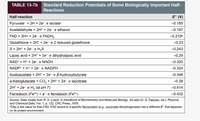
Biochemistry
6th Edition
ISBN: 9781305577206
Author: Reginald H. Garrett, Charles M. Grisham
Publisher: Cengage Learning
expand_more
expand_more
format_list_bulleted
Question

Transcribed Image Text:Standard Reduction Potentials of Some Biologically Important Half-
Reactions
Half-reaction
E" (V)
Pyruvate- + 2H + 2e → lactate-
-0.185
Acetaldehyde + 2H* + 2e- → ethanol
-0.197
FAD + 2H+ + 2e → FADH2
-0.219a
Glutathione + 2H* + 2e- → 2 reduced glutathione
-0.23
S+ 2H* + 2e → H2S
-0.243
Lipoic acid + 2H* + 2e- → dihydrolipoic acid
-0.29
NAD* + H* + 2e → NADH
-0.320
NADP* + H* + 2e- → NADPH
-0.324
Acetoacetate + 2H* + 2e- > B-hydroxybutyrate
-0.346
a-Ketoglutarate + CO2 + 2H* + 2e- → isocitrate
-0.38
2H* + 2e- > H2 (at pH 7)
--0.414
Ferredoxin (Fe3+) + e- → ferredoxin (Fe2+)
-0.432
Source: Data mostly from R. A. Loach, in Handbook of Biochemistry and Molecular Biology, 3rd edn (G. D. Fasman, ed.), Physical
and Chemical Data, Vol. 1, p. 122, CRC Press, 1976.
This is the value for free FAD; FAD bound to a specific flavoprotein (e.g., succinate dehydrogenase) has a different E" that depends
on its protein environment.

Transcribed Image Text:Calculate the standard free-energy change, deltaGo, for the reaction in which acetaldehyde is reduced by the biological electron carrier
NADH in the reaction acetaldehyde + NADH + H* → ethanol + NAD*. Then calculate the actual free-energy change, deltaG, when the
acetaldehyde is 1.85 M, the NADH is 1.55 M, the ethanol is 0.10 M and the NAD* is 0.10 M, at 28.22°C and pH = 7. Give the actual
free-energy change in kJ/mol to one decimal place. See Table 13-7b for the E° values.
Table 13-7b: Standard Reduction Potentials of Some Biologically Important Half-Reactions (link opens in new page)
Expert Solution
This question has been solved!
Explore an expertly crafted, step-by-step solution for a thorough understanding of key concepts.
This is a popular solution
Trending nowThis is a popular solution!
Step by stepSolved in 2 steps

Knowledge Booster
Similar questions
- Understanding the Mechanism of the 3-ketosphinganine Synthase Reaction Write a reasonable mechanism for the 3-ketosphinganine synthase reaction, remembering that it is a pyridoxal phosphate-dependent reaction.arrow_forwardThe Reactions and Meehanisms of the Leloir Pathway Write the reactions that permit galactose to be utilized in glycolysis. Write a suitable mechanism, tor one of these reactions.arrow_forwardExtending the Mechanism of Methylmalonyl-CoA Mutase to Similar Reactions Based on the mechanism for the methylmalonyl-CoA mutase (see problem 14), write reasonable mechanisms for the following reactions shown.arrow_forward
- Examine the ActiveModel for alcohol dehydrogenase and describe the structure and function of the catalytic zinc center.arrow_forwardREFLECT AND APPLY An inhibitor that specifically labels chymotrypsin at histidine 57 is N-tosylamido-L-phenylethyl chloromethyl ketone. How would you modify the structure of this inhibitor to label the active site of trypsin?arrow_forwardDistinguishing the Mechanisms of Class I and Class I Aldolases Fructose bisphosphate aldolase in animal muscle is a class 1 aldolase, which forms a Schiff base intermediate between substrate (for example. fructose-1, 6-bisphosphate or dihydroxyacetone phosphate) and a lysine at the active site (see Figure I8.12). The chemical evidence for this intermediate conies from studies with aldolase and the reducing agent sodium borohydride, NaBH4. Incubation of the enzyme with dihydroxyacetone phosphate and NaBH4 inactivates the enzyme. Interestingly, no inactivation is observed if NabH4 is added to the enzyme in the absence of substrate. Write a mechanism that explains these observations and provides evidence for the formation of a Schiff base intermediate in the aldolase reaction.arrow_forward
- Energetic of Fructose-1 ,6-bis P Hydrolysis (Integrates with Chapter 3.) The standard free energy change (G) for hydrolysis of fructose-1. 6-bisphosphate (FBP) to fructose-S-phosphate (F-6-P) and P: is -16.7 KJ/mol: FBP + H2O fructose-6-P + Pi The standard free energy change (G) for ATP hydrolysis is -30.5 KJ/mol: ATP + H2O ADP + Pj What is the standard free energy change for the phosphofructokinase reaction: ATP + fructose-6-P ADP + FBP b. What is the equilibrium constant for this reaction? c. Assuming the intracellular concentrations of [ATP] and (ADP] are maintained constant at 4 mM and 1.6 mM, respectively, in a rat liver cell, what will be the ratio of [FBP]/[fructose-6-P] when the phosphofructokinase reaction reaches equilibrium?arrow_forwardExplaining the Stoichiometry of Fatty Acid Synthesis Carefully count and account for each of the atoms and charges in the equations for the synthesis of palmitoyl-CoA, the synthesis of malonyl-CoA, and the overall reaction for the synthesis of palmitoyl-CoA from acetyl-CoA.arrow_forwardTracing the Fate of CO2 During Photosynthesis 14C-labeled carbon dioxide is administered to a green plant, and shortly thereafter the following compounds are isolated from the plant: 3-phosphoglycerate, glucose, erythrose-4-phosphate, sedoheptulose-1 .7-bisphosphate, and ribose-5-phosphate. In which carbon atoms will radioactivity be found?arrow_forward
- RECALL Several of the enzymes of glycolysis fall into classes that we will see often in metabolism. What reaction types are catalyzed by each of the following: (a) Kinases (b) Isomerases (c) Aldolases (d) Dehydrogenasesarrow_forwardUsing the ActiveModel for aldose reductase, describe the structure of the TIM barrel motif and the structure and location of the active site.arrow_forwardNearly all organisms on Earth carry out some form of glycolysis. How does this fact support or not support the assertion that glycolysis is one of the oldest metabolic pathways?arrow_forward
arrow_back_ios
SEE MORE QUESTIONS
arrow_forward_ios
Recommended textbooks for you
 BiochemistryBiochemistryISBN:9781305577206Author:Reginald H. Garrett, Charles M. GrishamPublisher:Cengage Learning
BiochemistryBiochemistryISBN:9781305577206Author:Reginald H. Garrett, Charles M. GrishamPublisher:Cengage Learning BiochemistryBiochemistryISBN:9781305961135Author:Mary K. Campbell, Shawn O. Farrell, Owen M. McDougalPublisher:Cengage Learning
BiochemistryBiochemistryISBN:9781305961135Author:Mary K. Campbell, Shawn O. Farrell, Owen M. McDougalPublisher:Cengage Learning Biology 2eBiologyISBN:9781947172517Author:Matthew Douglas, Jung Choi, Mary Ann ClarkPublisher:OpenStax
Biology 2eBiologyISBN:9781947172517Author:Matthew Douglas, Jung Choi, Mary Ann ClarkPublisher:OpenStax Human Heredity: Principles and Issues (MindTap Co...BiologyISBN:9781305251052Author:Michael CummingsPublisher:Cengage Learning
Human Heredity: Principles and Issues (MindTap Co...BiologyISBN:9781305251052Author:Michael CummingsPublisher:Cengage Learning

Biochemistry
Biochemistry
ISBN:9781305577206
Author:Reginald H. Garrett, Charles M. Grisham
Publisher:Cengage Learning

Biochemistry
Biochemistry
ISBN:9781305961135
Author:Mary K. Campbell, Shawn O. Farrell, Owen M. McDougal
Publisher:Cengage Learning

Biology 2e
Biology
ISBN:9781947172517
Author:Matthew Douglas, Jung Choi, Mary Ann Clark
Publisher:OpenStax

Human Heredity: Principles and Issues (MindTap Co...
Biology
ISBN:9781305251052
Author:Michael Cummings
Publisher:Cengage Learning